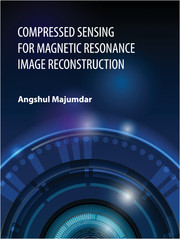Book contents
- Frontmatter
- Contents
- List of Figures
- List of Tables
- Foreword
- Preface
- Acknowledgements
- 1 Mathematical Techniques
- 2 Single Channel Static MR Image Reconstruction
- 3 Multi-Coil Parallel MRI Reconstruction
- 4 Dynamic MRI Reconstruction
- 5 Applications in Other Areas
- 6 Some Open Problems
- Index
- About the author
- Color Plates
6 - Some Open Problems
Published online by Cambridge University Press: 05 June 2016
- Frontmatter
- Contents
- List of Figures
- List of Tables
- Foreword
- Preface
- Acknowledgements
- 1 Mathematical Techniques
- 2 Single Channel Static MR Image Reconstruction
- 3 Multi-Coil Parallel MRI Reconstruction
- 4 Dynamic MRI Reconstruction
- 5 Applications in Other Areas
- 6 Some Open Problems
- Index
- About the author
- Color Plates
Summary
In this chapter, we will explore some open problems in MR reconstruction. This is not an exhaustive list and only reflects the problems that interest us. This chapter will point to some future directions of research for the interested reader.
Interactive Sampling
Brain is a complex structure and in order to get a high quality image, the number of samples required by compressed sensing (CS) reconstruction techniques is higher. One needs about 67 spokes to yield a decent quality image; anything less than that loses a lot of structure. On the other hand, the structure of the heart is relatively simple; therefore, the number of samples required to recover a good quality image is much less (compared to the brain). We get very good image only with 37 radial spokes (Fig. 6.1). Usually the more complex the structure is, more the number of K-space measurements needed to yield good quality images. If we are studying vasculature, the number of K-space measurements needed may be even more.
So far, most of the effort has been expended in coming up with new modeling techniques to represent MR images – sparsity, low-rank, combination of both, etc. There have been some interest in coming up with efficient K-space sampling strategies that are conducive to CS reconstruction. The usual way to present these studies is to take a fully sampled image as the ground-truth and show that their method (new algorithm/sampling strategy) yields good results. Prior studies did not study the fundamental question of estimating/guessing the number of samples required for reconstructing the image.
As we have shown here, there is no fixed undersampling ratio that will uniformly yield good results for all anatomical structures – unless the ratio is too pessimistic (similar to the range of full sampling). For the brain image, we need 62 lines; for a cardiac image, a similar quality image is obtained with just 37 lines – 62 lines in this case is an overkill. Our objective is to yield same (good) quality images for all anatomical sections with the minimum possible number of samples (fastest possible acquisition).
In the first chapter, we learned about CS theory.
- Type
- Chapter
- Information
- Compressed Sensing for Magnetic Resonance Image Reconstruction , pp. 194 - 206Publisher: Cambridge University PressPrint publication year: 2015



